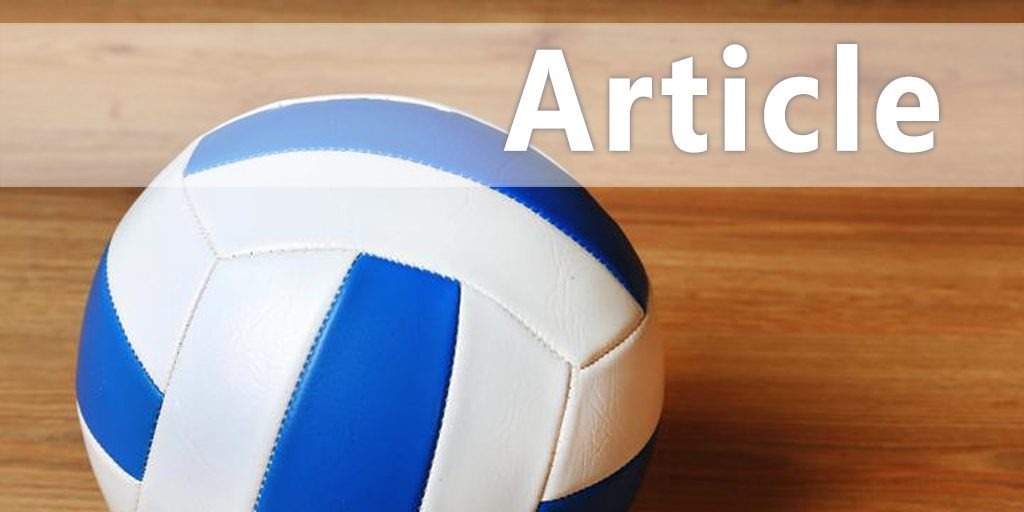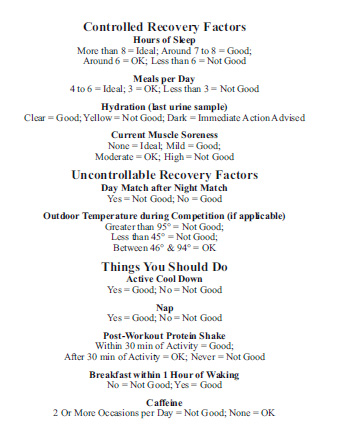| Putting Volleyball Parents to Work as Recovery Coaches |
| By: Ken Kontor
Originally Published in: Coaching Volleyball Provided by: AVCA HOW IT WORKS Parents Recovery Score Card 1. Complete daily prior to activity. 2. Give points for positive activities and situations and take points away for negative 3. Add total score. 4. Monitor total score over time. 5. Share with coach. Fill out prior to activity. Controlled Recovery Factors Hours of Sleep: 7-8 hours = 2, 6 hours = 1, 5 or less = 0 Meals per Day: 4-6 meals = 2, 3 meals = 1, 2 or less = 0 Hydration: (last urine sample) Clear= 2, Yellow = 0, Dark = -1 (minus) Current Muscle Soreness: None= 3, Mild = 2, Moderate = 1; High = 0 Uncontrollable Recovery Factors Day Match after Night Match: Yes= 0, No = 2 Outdoor Temperature during Competition (if applicable): Greater than 95° = 0, Less than 45° = 0, Between 46° and 94° = 1 Active Cool Down: Yes= 2, No = 0 Nap: Yes = 2, No = 0 Post-workout Protein Shake: Within 30 min of Activity = 2; After 30 min of Activity = 1; Never = 0 Breakfast within 1 Hour of Waking: Yes = 2, No = 0 Caffeine: 2 or More Occasions per Day = 0; None = 1 19 = Ideal Score - Get your totals as close to that as possible.
HOW TO MAKE IT WORK FOR YOU • Collect the data from your parents weekly. • Overtime, the more data collected the more meaningful the results. • Compare activity with recovery and adjust accordingly. • Look for valleys that may occur in one or two athletes. It may mean they are doing too much outside activity. Talk to the parents about this situation. HOW IT FITS Based on our "Fit-to-a-T" 7-T system of program design. Here are some important considerations to T-6 Total Workload which considers recovery: Determine your Total Workload to ensure your athletes develop in a progressive fashion with adequate recovery by balancing practice/competition work with conditioning work. This is a challenge because of the busy lives athletes lead today. The ultimate responsibility of the strength and conditioning program must be that of the volleyball coach. This is done by establishing a calendar (T-2) that identifies and integrates total workload based on competition, practice and strength and conditioning training. Competition should include scholastic and club play. Practice should consider strength and/or conditioning activities done on the court including warm-up and jump training, etc. Strength and conditioning should include training with the school's/club's strength and conditioning coach and other training outside the volleyball coach's control, such as at a private gym. In the case of a multi-sport athlete, the volleyball coach should have the additional task of communicating with other sport coach(es) as to the progress of the athlete. The final outcome is to provide adequate recovery based on total workload to allow the athlete to progress physically, improve volleyball skills and reach their full athletic potential through this seamless integration process. Acknowledgment: Recovery Score Card content developed by Brendon Huttmann, Strength and Conditioning Coach, Pittsburgh Pirates |








